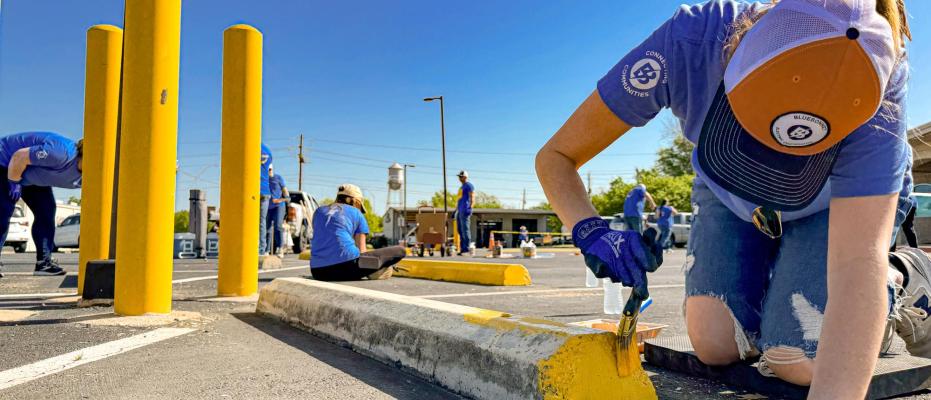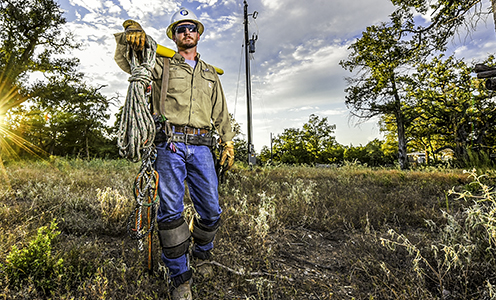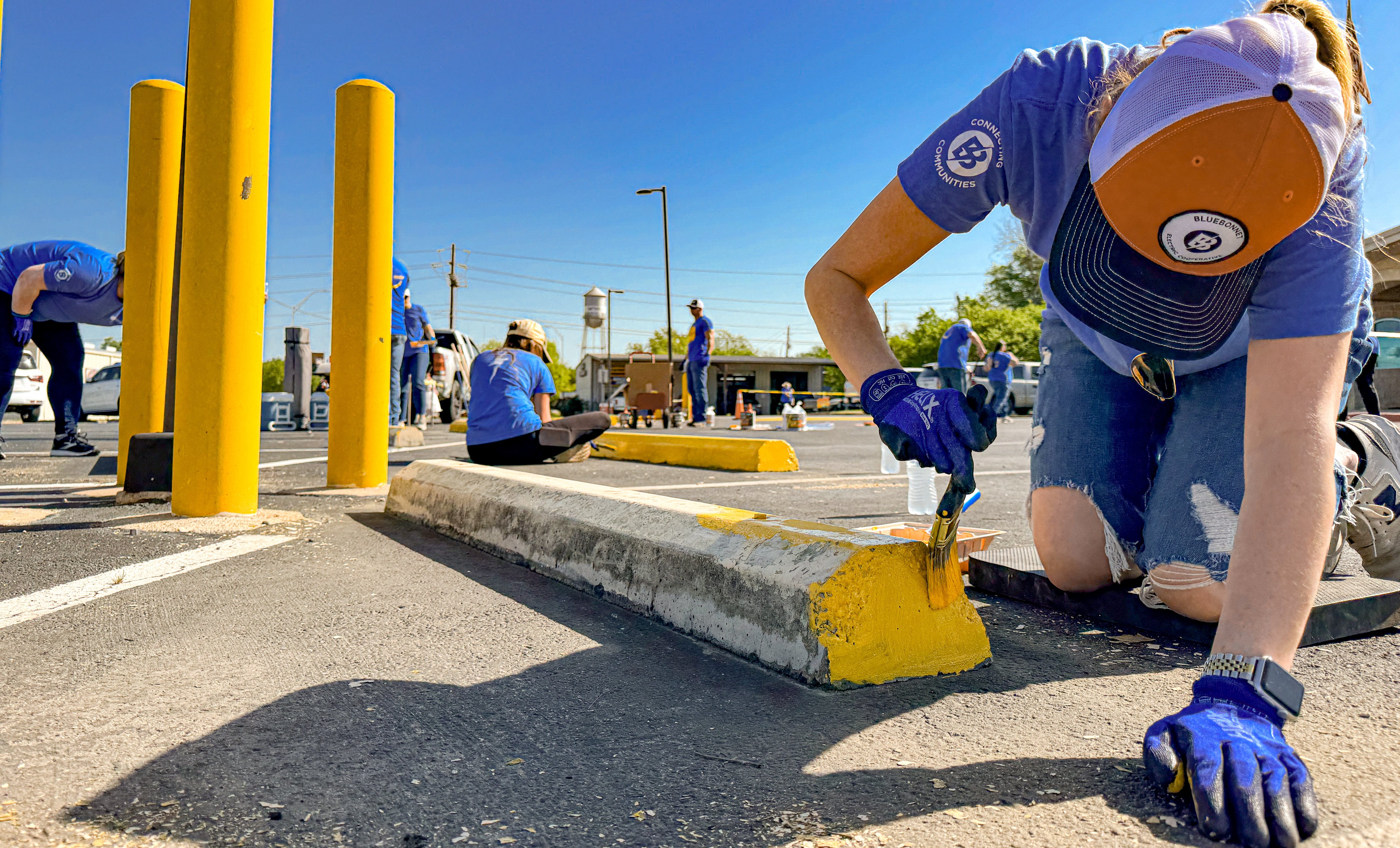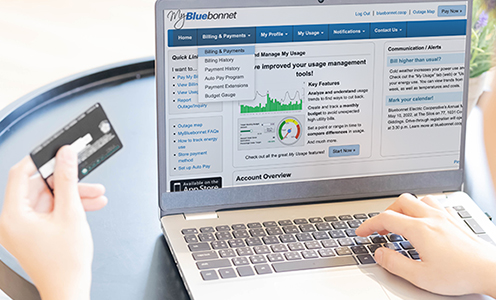We’re your neighbors
We live here. We work here. From volunteer events to storm recovery, our crews and staff are the familiar faces you see every day. Giving back to the communities we serve — it’s our shared mission.

Community news
By Sharon Jayson
Amy Fritsch and her family in Fayette County never planned to be trendsetters.
But when they added a swimming pool, outdoor kitchen and other improvements to make the most of their backyard three years ago, they had no idea that thousands of other families soon would follow their lead, motivated by months of stuck-at-home time due to COVID-19.
We learned this year just how important spending time outdoors can be to both physical and mental health. Once we were locked down at home, being outside became the only safe way to entertain friends and family who aren’t part of the household. Just stepping outside into nature boosts mood and mindset, especially when we’ve been cooped up inside working and being with family 24/7.
The Fritsch family — which includes husband Brad and sons Lane, 19; Logan, 16; and Lawson, 13 — had planned to spend much of the 2020 summer traveling around Texas for their younger sons’ baseball and basketball games. The coronavirus outbreak canceled those games and turned the family’s outdoor living space into a haven in Willow Springs, an unincorporated community in Fayette County. They’ve used the amenities a lot – from frequent cookouts to twice weekly water aerobics for a group of friends.
“We’re out there cooking at least three nights a week,” Amy Fritsch said. “We used it more than in a typical summer.”
When summer gave way to fall’s chill, time in family outdoor spaces didn’t have to end. Portable and installed heaters for patios and screened porches are just what people needed to extend the life of their outdoor areas, said Enrique Amaro, co-owner of Austin-based MCS Outdoor Living Specialists, which serves areas across Central Texas.
“Everybody wants to condition their houses to be able to stay out there,” he said.
His company, which launched in 2003 with mosquito control systems, has expanded and rebranded to provide outdoor living amenities, including misting systems, outdoor heating and fire pits.
Summer 2020 was unlike any other for professionals who improve a home’s outdoor areas, said Lucas Stroech, a landscape architect, contractor and licensed irrigator with Washington County Landscapes in
Brenham.
“We’re busier than we’ve ever been,” he said in August. “We’re doing double the amount of work we normally do. We expanded and added more crews. We could expand again, but we can’t physically handle any more.”
Stroech’s company and others that provide residential outdoor living services agree that because a family’s house has become a combination workplace, camp and school, homeowners are more inclined to spruce up their surroundings.
“They’re not going on vacations, dining out or going to concerts,” which has freed up money to spend on outdoor projects, said Kermit Baker, director of the Remodeling Futures Program at Harvard University’s Joint Center for Housing Studies.
“Outdoor living and outdoor projects — decking, porches, outdoor kitchens, pools — are all very strong,” he said, noting that people also opt for outdoor upgrades in part because workers don’t have to go inside.
Brian Fischer of Fischer Langham Custom Homes in Giddings says this year’s customers have “gotten a bit more extravagant.”
Whether it’s a new home or additions to existing homes, his clients aren’t just creating backyard barbecue areas. They’re adding fireplaces, swimming pools, sitting areas and TV spaces. Also, more homeowners want screened porches to make the most of outdoor evenings. Those porches often have automated screens and shutters, he said. Some homeowners even have air-conditioned porches.
Such amenities are pricey, though.
For those installing outdoor kitchens, the key is to “blend with the environment,” Fischer said.
“Most outdoor kitchens are covered to take advantage of the prevailing breezes as well as how the sun travels through the day. The roof will help shade the structure. In the afternoon, when the west sun is setting, you don’t want to have the grill on the west side,” Fischer said.
Ryan Pape, owner of Papescapes, based in Burton, said his customers ask for “open-air entertaining.”
“They’re wanting more of an outdoor entertaining area — not just fire pits and fire rings but outdoor kitchens and outdoor spaces,” he said. “There is an uptick for pools as well.”
Some customers install sliding glass walls on the house to bring the outdoors in. It’s part of a home improvement trend that began in recent years to integrate homes with their natural surroundings. Glass wall systems welcome in nature and can have automated controls. However, Pape says such features are less efficient in Texas, where summer heat isn’t always a welcome indoor guest. To beat the heat, some buy misting systems to cool the air.
Amaro’s company added mist cooling systems in 2008 and has since added outdoor heating systems and outdoor and accent lighting. It also collaborates with other companies to build outdoor kitchens and pools.
“You spend all that money on a patio and pool and are ready to enjoy it and then you go outside and cannot be there — either the mosquitos are going to kill you or the heat will,” he said.
Experts say grilling outdoors offers a twofer on energy savings. In warm weather you avoid heating up the house from the oven or stove, meaning less AC to keep the house cool. And cooking on fuel-efficient grills saves more power than using the oven. Creating an outdoor kitchen can be expensive, but outdoor professionals say it can save hundreds of dollars a year in electric and gas bills.
For an eco-friendly outdoor kitchen, infrared gas-powered grills are a good way to go. They use about 25 percent less gas than other grills, and save money and natural resources. Charcoal grills are more fuel efficient, and rounded, ceramic “kamado” grills such as the Big Green Egg can use 100 percent natural lump charcoal made from unused log sections and recycled wood, experts say. Other types of charcoal can be used as well.
If you want a fridge in your outdoor kitchen, Dave Rebtoy, The Home Depot’s regional vice president over the Southwest, has a key efficiency tip. “If you install a refrigerator in an outdoor kitchen, it needs to be an outdoor refrigerator,” he said. “They’re different. People put mini-fridges outside and they won’t stay cool. If you put it in an enclosed space, it needs to vent.”
The Home Depot offers all sorts of advice about outdoor living DIY projects, Rebtoy said.
When large outdoor projects require lighting, plumbing or other technical skills, many homeowners hire a professional. That’s what Andrew Murrell did. After gutting and renovating a house in Bellville, he and his family moved there from Houston last fall.
When Murrell cut back his 124-mile round trip commute to his job in Houston to twice weekly because of the pandemic, the family started on a two-part outdoor project that initially included landscaping, a basketball court and sitting area.
That’s when Murrell’s family realized how lucky they were: the pandemic “heightened the need for the large gathering space to sit around and apart from each other,” Murrell said.
A swimming pool and cabana were completed this fall, Murrell said. The total cost of the outdoor projects was $350,000, including the $100,000 pool cost.
Dede and Brian Kaplan drive every week from Houston to their weekend house in Burton that sits on just over 12 acres. But during the pandemic, they’ve spent more time in Burton, including the period when much of the country was shut down last spring.
“Being out here those three weeks was really wonderful and made us realize we could spend a lot of time here. We were happy we were improving the property so we could enjoy more of it,” Dede Kaplan said.
Although they’ve owned the Burton house for three years, they didn’t start their outdoor project until earlier this year. They added a casita, swimming pool and landscaping.
Families who invest in outdoor living spaces may be helping their health, according to increasing numbers of studies showing that spending time outside is good both mentally and physically. Enjoying nature appears to boost well-being amid the swirl of stress and anxiety produced by the pandemic.
“This paper adds value to the literature in showing that a dose of as little as 10–20 minutes of sitting or walking in an array of green spaces can have a meaningful impact in reducing stress, anger, anxiety, and in increasing vigor, comfort, positive affect and a sense of feeling refreshed,” said one study published in Frontiers in Psychology in January.
Research conducted by psychologist Marc Berman, director of the Environmental Neuroscience Laboratory at the University of Chicago, finds similar benefits. Those working at home may experience “directed attention fatigue,” making it difficult to focus after hours spent online, he said, but spending time among natural elements such as trees, plants, water or animals is “going to help restore your attention. If you don’t have a lot of trees in the backyard, add some plants. We’re finding anything you have can help,” Berman said.
CHOOSING A HEATER TO KEEP YOUR SPACE WARM
Today’s heaters for backyard outdoor living aren’t limited to the mushroom shaped styles that tower over restaurant patios. Newer options have different looks and warm up larger areas.
The type of outdoor heater that’s right for you depends on the age of your home and how you can power it.
Older homes may have limited power availability. A newer house typically comes with more electrical power and may have an outdoor gas connection.
If it’s available, gas heat is a good option, said Enrique Amaro, co-owner of MCS Outdoor Living Specialists.
Large electric heaters use 220 volts, versus the 110 volts from a home’s standard electric outlet. Using gas heaters outdoors can help prevent your electric bill from spiking. If you don’t have natural gas, or your backyard doesn’t have the proper power, a portable heater is the best option, Amaro said.
Prices of top-quality outdoor heaters vary by coverage area and power type. Higher-end electric or gas heaters that are installed by professionals can cost $1,500 to $2,000 per heater, Amaro said. Each of those portable heaters can cover about 200 square-feet, he said.
If that is out of your price range, all sizes of gas- and propane-powered portable heaters are sold at large retailers like The Home Depot or Lowe’s. Name-brand outdoor heaters can also be purchased online. Larger heaters start at about $100 but many are $300 or higher.
There are many safety requirements and guidelines for gas and propane powered outdoor heaters. Pay close attention to instructions and warnings, and make sure that the heater you select is intended for outdoor use.
DIY OR GO WITH A PRO? THINGS TO KEEP IN MIND
Everyone is spending more time at home, so home improvement projects may be on your to-do list. But your do-it-yourself skills may not be up to complex projects like creating outdoor living environments. Here are some key FYIs for DIYs, courtesy of The Home Depot.
TIME: First, do you actually have time to do a project yourself? Smaller tasks, such as building a table, can take a weekend or a few days. But an outdoor deck or larger projects may require several weeks of time.
COST: DIY almost always saves you money. But be sure to assess your budget in relation to the time and eort needed to tackle the project yourself. Consider asking a professional for a cost estimate before you start.
SCOPE OF WORK: How big is your project? It’s best to start small for your first attempt at DIY as you build your skills. It may be worth hiring a contractor for larger projects.
EQUIPMENT: Know which tools are needed to complete a project and whether you have them on hand. The Home Depot, Lowe’s and other stores oer rentals if your tool arsenal is limited. If you’re not familiar with which tools are best for a project or are unsure how to use the tools, it may be safer and more ecient to hire a pro.
SKILL: DIY is always an excellent way to learn, but if a project is complex or requires skilled labor — such as for electrical wiring — it’s important to know whether you have the ability to complete the project safely. It’s best to let a professional handle electrical wiring.
PERMITS: Be sure to check your local building permit laws to ensure you can legally make renovations or undertake a project without involving a professional.
COMPLICATING FACTORS: Consider every aspect necessary to complete a project. Will plumbing be involved? Do you need to supply electricity? If water and power sources will be aected, you most likely will need to hire a contractor to ensure everything is done by the book and that your project can be completed safely.
COST ESTIMATES: The cost of installing a basic outdoor kitchen or adding an outdoor covered area like a pergola varies widely based on size, design, material and location. General construction for an outdoor kitchen may range from $3,000 to over $10,000. Cost of a pergola may range from $2,000 to $10,000.
Download this story as it appeared in the Texas Co-op Power magazine »
The Blue Volunteer Fire Department will soon construct a new building and renovate the existing fire station, thanks to a $49,565 grant from the Lower Colorado River Authority and Bluebonnet Electric Cooperative.
The Community Development Partnership Program grant, along with $13,150 in matching funds from the department, will allow BVFD to expand its resources to continue to meet the needs of the community. The new building will assist in housing the department’s growing fleet of emergency response vehicles, while a renovation to the existing station will create a space for training and community meetings.
“We service a little over 100 square miles of mostly rural farmland, but we are seeing an influx of people coming from the Austin area and our population is growing,” Fire Chief Rick Isaacks said. “There are plans for developing new RV plots and tract housing, and our call volume is increasing.”
The department is committed to anticipating and preparing for a rise in the demand of its services.
“As we have more people move out here, we’re seeing different types of emergencies,” Isaacks said. “In the last several years, we’ve brought the department to another level as far as equipment, training and response capability goes.”
Currently, the area lacks a community events center. The grant will help the department create a meeting space for operations and fire safety trainings that will also be available to local groups.
“This will open up opportunities for nonprofits to have a meeting place,” Isaacks said. “They’ll have a bathroom and kitchen area, too. It helps us give back to the community.
“We are very appreciative for LCRA and Bluebonnet granting this to us,” he said. “This is a big need that we’ve been trying to accomplish for many years. We’re trying to stay ahead of the growth in the area so we can maintain the high level of response that our people deserve. Our volunteers just want to help the community. That’s what it is all about for us.”
The community grant is one of 27 grants awarded recently through LCRA’s Community Development Partnership Program, which helps volunteer fire departments, local governments, emergency responders and nonprofit organizations fund capital improvement projects in LCRA’s wholesale electric, water and transmission service areas. The program is part of LCRA’s effort to give back to the communities it serves. Bluebonnet Electric Cooperative is one of LCRA’s wholesale electric customers and is a partner in the grant program.




